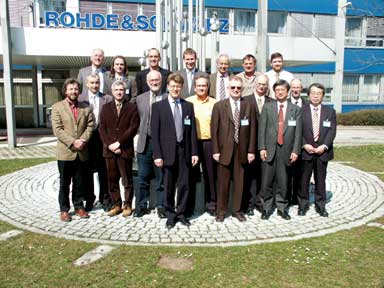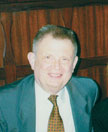At the end of March, the Special International
Committee on Radio Interference (CISPR) of the International Electrotechnical
Commission (IEC) Subcommittee A Working Groups met in Munich at
the headquarters of Rohde & Schwarz. Manfred Stecher, chairman
of SC A/WG2 and key R&S EMC standards person as well as a
most active subcommittee working group technical contributor,
was the gracious host. That extended not only for the meeting
but also for sampling the “best” of local liquid and
non-liquid German cuisine each evening.
This mid-term (between the normal annual gathering with the parent
subcommittee) meeting of the working groups was necessitated due
to the heavy load in getting their work discussed, agreements
reached, and then moving on to publication. The output of Subcommittee
A (SC A) is primarily in the CISPR Publication 16 series which
is the major horizontal (basic) standard series for EMC measurement
methods and associated measurement instrumentation as well as
statistical techniques and measurement uncertainty. [1] These
standards are then referenced and incorporated within the various
CISPR product committee standards which include industrial, scientific,
medical, information technology, radio receiver, TVs, appliances,
lighting, and automotive equipment.
Briefly, Working Group 1, which deals with EMC measurement instrumentation
(primarily the CISPR Pub 16-1-X series of standards), focused
on these activities:
a. Influence of setup tables and antenna towers
on compliance testing
b. Calibration of Common Mode Absorption Devices (CMAD) for limiting
CM currents
c. Receiver specifications to 18 GHz
d. Weighting of interference according to its effect on digital
communication services
e. Spectrum analyzers and scanning receivers for the frequency
range 1 GHz to 18 GHz: Amplitude Probability Distribution (APD)
f. Line Impedance Stabilization Networks (LISNs) specifications
g. Validation of test sites for measurement of radio disturbance
field strength for the frequency range 1 GHz to 18 GHz
h. Calibration of the absorbing clamp in the frequency range 30-1000
MHz
i. Capacitive voltage probes specifications
j. Antenna calibration processes to complement the antenna calibration
test site standard already published in CISPR Pub 16
k. Emission and immunity testing in transverse electromagnetic
(TEM)
waveguides
l. Validation of fully absorber lined rooms (FARs) for emissions
and immunity testing, between CISPR/A and SC77B
m. Mains-connection induced EUT uncertainties: list of uncertainty
sources and
proposals for measurements
n. Maintenance activity of CISPR 17 publication on use of RF filters
Working Group 2 (Methods of Measurement and
Uncertainty) also has a wide variety of activities including:
a. Measurement methods above 1GHz
b. Alternative test site suitability without a ground plane
c. Measurements using the absorbing clamp, 30 MHz to 1000 MHz
d. Conditions for the use of alternative test methods
e. Rules for applying the statistical 80/80 rule and use of partial
frequency ranges
f. Measurements in absorber-lined shielded enclosures-Uniform
measurement arrangement for radiated emission and immunity testing
g. Compliance uncertainty of absorbing clamp measurements
h. A model for the calculation of limits (being transferred to
SC H of CISPR)
i. Reverberation chamber test methods
j. Compliance uncertainty of radiated emissions measurements
k. APD (Amplitude Probability Distribution) measurement method
l. Measurement of conducted disturbances
m. Scan rates and measurement times for use with the average detector
It is worthy to note that CISPR Subcommittee
A has four joint task forces (JTFs) with IEC TC77 (EMC) which
is primarily associated with writing the IEC 61000-4-X and 3-X
series of immunity and low frequency emission standards, respectively.
These joint projects affect both emission and immunity measurement
activity, which was the reason for the joint effort. The work
has been split between WG1 and WG2 as noted above with WG1 concentrating
on validation in general and WG2 focusing on the measurement techniques.
The subject of these four JTFs is as follows:
a. Testing using transverse electromagnetic
(TEM) devices
b. Testing using reverberation techniques
c. Uniform arrangements for both radiated emission and radiated
immunity testing in a single test chamber
d. Measurements made in fully absorber lined rooms (FARs)
As you can see from the above, there is significant
activity in work both below 1000 MHz and most importantly above
1 GHz including test site validation, test procedures, instrumentation
and product testing guidance. Note that all the work of CISPR
Subcommittee A serves the product committees, but it is the product
committee’s decision when they use the material in CISPR
Pub 16, with the expectation that any needs of a basic nature
not addressed, be referred to Subcommittee A for the subcommittee
and its WGs to deliberate and to amend and add to its publication
for use by the product committees. Please note that if you are
interested in more information on CISPR Subcommittee A (and any
other CISPR product and generic standards subcommittees), contact
your IEC/CISPR mirror committee in your country. This information
can be gained again by looking at the IEC web site (www.iec.ch)
and by clicking on the “Search” red button on the top
right of the home page. Then select “IEC Members.” Once
on that page, click on your country’s name. The address and
name of your country’s IEC secretary is there where you can
send an email with your request.
[1] For more information on the breakdown of the CISPR 16 standards,
log onto the IEC website (www.iec.ch)
and search on “cis/a” and then “published documents.”
EMC
 |
Upper row from left: Manfred Stecher
(Convener of SC A WG2), Rohde & Schwarz, Germany; Udo
Kappel, EMC Test NRW, Germany; Pierre Beeckman, Philips, Netherlands;
Alexander Kriz, ARCS Seibersdorf Research, Austria; Heinrich
Ryser, Swiss Federal Office of Metrology and Accreditation
(METAS), Switzerland; Ken Hall, HP, USA; and Clark Vitek,
Extreme Networks, USA.
Lower row from left: Philippe Lancelin, France Telecom, France;
Lutz
Dunker, Regulatory Authority for Telecommunications and Post
(RegTP), Germany; Beniamino Gorini (co-convener of SC A WG2),
Alcatel, Italy; Ole Soerensen, Nokia, Denmark; Janne Nyman
(co-convener of SC A WG1), NEMKO, Finland; Werner Schaefer
(Convener of SC A WG1 and secretary of SC A), Cisco, USA;
Don Heirman (Chairman of SC A), Don HEIRMAN Consultants, USA;
John Mowbray, NCR, Canada; Yuko Yamanaka, Communications Research
Labs (CRL), Japan; Martin Alexander, National Physics Laboratory
(NPL), United Kingdom; and Takashi Shinozuka, CRL, Japan. |
ANSI C63.4 and Comparisons with CISPR 22
Activity Workshop Announcement
As has been provided for many years before the annual US location
EMC symposium, ANSI ASC C63 and the US EMC Standards Corporation
will again host a two and a half day workshop. The workshop will
review the use of the new C63.4-2003 (released in January 2004)
and compare it with the IEC CISPR Pub 22 including proposed changes
to these documents that have been highlighted for both editions.
The dates are 5-7 August 2004 (note it is more than a week earlier
this year as the symposium is also a week earlier than in Boston
2003). The workshop will indeed be a workshop in that we continue
to have a problem solving segment where teams are formed that
work on different problems depending on their familiarity with
the use of the standard. Again, we will have Art Wall from the
FCC as a guest speaker to describe changes in the FCC rules and
the way in which they reference C63.4 as the mandatory way to
perform testing to specific Part 15 devices. For more information
and registration, contact Janet O’Neil on
j.n.oneil@ieee.org. Also note that the registration form is
in the advance program for the 2004 IEEE International Symposium
on EMC in Santa Clara, California. EMC
|
|
|
 EMC
Standards Activities
EMC
Standards Activities